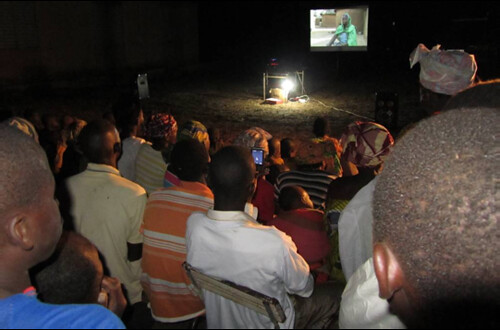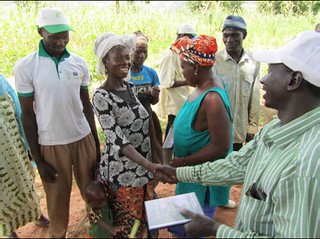Using films to support large-scale training on Striga and soil fertility management in Mali

For the past 40 years, scientists from international research organizations such as the International Crops Research Institute for the Semi-Arid-Tropics (ICRISAT), the International Maize and Wheat Improvement Center (CIMMYT) and the International Institute of Tropical Agriculture (IITA) have invested heavily in finding solutions to one of the world’s most troublesome weeds, known as witchweed or Striga. Of great concern to African farmers, this parasitic weed damages maize, sorghum, millet, rice and fonio. While developing Striga-resistant crop varieties is a key area of research in Striga control, researchers have also developed insights into how soil fertility management and other options can help to reduce Striga.
Over the years, scientific knowledge alone has proved insufficient in managing Striga, as researchers and agricultural extension agents have struggled to communicate effectively with farmers on the complex processes of managing the weed. Since 2006, ICRISAT and partners have conducted farmer field schools to experiment with a wide range of Striga control options. As a result, practical and profitable integrated Striga and soil fertility management (ISSFM) practices were developed for pearl millet and sorghum. However, bottlenecks such as the scarcity of skilled trainers and maintaining quality training have hampered efforts in scaling up the new practices.
But new efforts and intense collaboration between a private company Agro-Insight and ICRISAT partners in Niger, Nigeria, Ghana and Mali have led to the production of a series of 10 farmer-to-farmer videos on ISSFM practices. The films, produced in French and English and translated into six other major West African languages (Bambara, Bomu, Hausa, Mooré, Peulh and Zarma), were first produce in 2012.
Partnerships for distribution, viewing and use of ‘Fighting Striga’
The series of films, which are packaged in DVDs, is called ‘Fighting Striga’ and a comprehensive distribution and monitoring plan for the films was made with key stakeholders from Mali, Niger, Nigeria and Burkina Faso. Partners included local, national and regional organizations, ranging from national research institutes, chambers of agriculture and NGOs to farmers’ organizations, rural radio stations and seed companies. Of 30,000 DVDs produced in Mali and Nigeria, over 20,000 copies have already been distributed to a range of organizations and individuals, representing old and new partners. ICRISAT distributed individual or large quantities of DVDs to partners and other strategic development agencies (first level), These first level partners further distributed the DVDs within their networks (second level), which in turn distributed copies even further (third level). Intensive data collection and monitoring reveals that within a year the DVDs had reached over 2,000 representatives of about 700 organizations from 43 countries.

Partnerships were key to large-scale viewing and dissemination of the videos as the numbers of viewers rose to over 15,000 within 9 months, mostly as a result of partners’ efforts. Although it has been a challenge to collect feedback from (especially non-contracted) partners, many enthusiastic new partners have provided interesting feedback. Several NGOs, farmers’ organizations and rural radio broadcasters have responded positively to the request for feedback and often requested more DVDs, technical support documents and training of their field agents. According to them, the videos represent an opportunity to quickly acquire new knowledge on the subject and to engage with large numbers of farmers for exposure to, and discussions about, ISSFM. They also noticed a shift in the roles of field agents, technicians and researchers, who evolved from being teachers to facilitators in knowledge exchange between farmers and other stakeholders.
‘They [the farmers] enjoyed watching the [Arabic versions of the] videos, which encouraged them to comment and fully participate in the discussions,’ said Noureldin Ahmed Abdalla of the Sudan Meteorological Authority in Khartoum, Sudan.
While it is too early to assess the impact of these films, several partners in Mali and Niger observed communities mobilizing themselves to hand pull Striga near the end of the 2012 rainy season, as well as many farmers digging and filling compost pits. According to the partners, the farmers said their actions were a result of watching the videos.
‘The communities understood that fighting Striga requires concerted efforts to attain results, and I have already seen examples of community action to hand pull Striga,’ said Ali Mamane Aminou of the farmer organization Fumagaskiya in Maradi, Niger.
While the primary goals of the videos were to train farmers and extension agents, several universities in Africa and Europe have included the DVDs in their BSc and MSc curricula. They found the videos useful in illustrating the reality of smallholder farming in Africa, while at the same time showing new technologies and approaches to participatory research.
The Fighting Striga videos are effective because they are made according to the ‘zooming in’ and ‘zooming out’ method. This method relies on strong interactions with farmers who have been involved in participatory approaches such as farmer field schools and results in regionally relevant and locally appropriate farmer-to-farmer training videos.
Promotion, buy-in and investment efforts from new partners
The international NGO Access Agriculture, which has established a video- and audio-sharing web-based platform devoted to supporting agriculture in developing countries, has made it possible to watch and download videos for farmers. Videos are also made physically available by large-scale multiplication and dissemination of DVDs based on national demand. In the meantime, the videos have been translated into seven languages for northern Ghana (Dagaari, Sisaala, Dagbani, Gonja, Kusaal, Buli and Frafra). Several governmental and non-governmental organizations have also discovered the quality and relevance of the videos and decided to invest in translation them into Arabic, Portuguese, Swahili (Kenya), Chichewa (Malawi), Dendi, Bariba and Nago (Bénin). Some agencies also supported large-scale production of DVDs and broadcasting the videos on national television, increasing visibility and availability even further. Through the promotion efforts of ICRISAT, Access Agriculture and partners, the videos are now reaching agricultural service providers and farmers not only in Western, but also in Eastern and Southern Africa. Africa RISING is one of the partners that paid for translation of the videos and also helped in distributing them. In July 2013, the project also created awareness among extension agents at a workshop in Ghana.
[youtube https://www.youtube.com/watch?v=karjrX7ErJE]
Written by Agathe Diame and Tom Van Mourik (ICRISAT).




